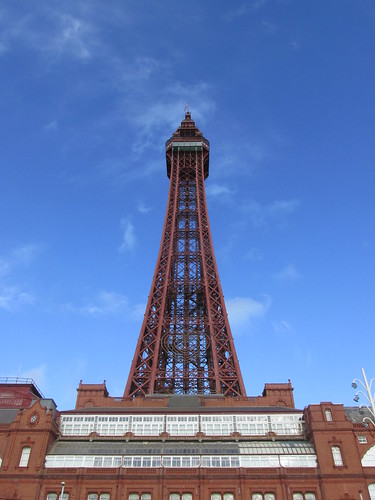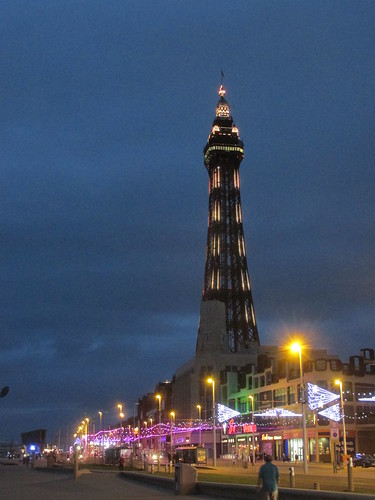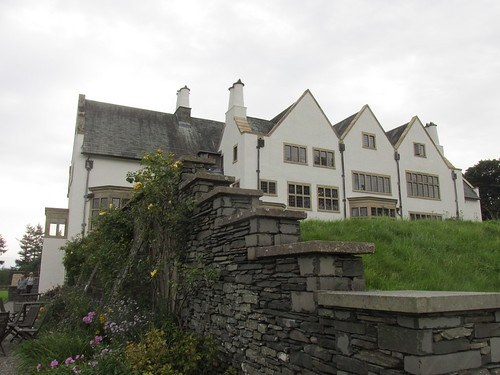*Blackpool Tower is one of the iconic images of northwest England. At 518 feet high (158 metres) the Grade I listed structure is the 103rd tallest free standing tower in the world. It was inspired by the Eiffel Tower.
It's nationally known as the traditional home of ballroom dancing, and it is currently the venue for a highlight of the BBC's Strictly Come Dancing. It also houses a circus ring, a high-rise observation deck with a glass floor, a 'house of horror' dungeon attraction, and the flagship branch of fish and chip chain Harry Ramsden's.
The architects were James Maxwell and Charles Tuke, two Lancashire men, but the structural engineers in charge of the project were Worcester-based Heenan and Froude. Construction took five million bricks, 2,500 tonnes of steel and 93 tonnes of cast iron.
The Tower opened on May 14, 1894 and on that day more than 3,000 people rode lifts to the top. By the 1890s seaside holidays were becoming popular. The 1871 Bank Holidays Act had created official public holidays throughout the year, and the growing railway network made travel easier and affordable for working families.
Blackpool had had a railway connection since the 1840s and by the time the Tower opened the town already had a promenade and many other seaside favourites: fish and chip shops, pubs, donkey rides, and gypsy fortune tellers. All three piers were complete, the South Pier opened just a year before the Tower. The world-famous illuminations opened in 1879.
The Tower was just the latest attraction designed to encourage holidaymakers and day trippers to part with their money. It cost sixpence (2.5p) to go inside, sixpence to ride the lift to the top, and another sixpence to watch the circus in the building below. The average wage at the time was £1 a week. A Blackpool Tower Circus ticket would cost you the best part of £20 today.
* As promised a couple of posts ago - more about Blackpool.
Saturday, 24 September 2016
Wednesday, 21 September 2016
Blackwell
Blackwell, widely known as The Arts and Craft House, perches on a hillside above Lake Windermere in Cumbria. It was built as a holiday home for Manchester brewery owner Sir Edward Holt and his family. Designed by architect M H Baillie Scott, and with gardens laid out by Thomas Mawson.
It was built between 1898 and 1900 at at the time was the height of design fashion. Today it's open to the public and many of its original details are still in place.
There are lots of signs all over the place that say you can't take photos, so sorry, this is a little drab. Best thing I can suggest is that, when you've read this summary, you visit the house's website.
Baillie Scott had gained a reputation among designers by publishing sketches and ideas in The Studio magazine. It was this reputation that arned him the commission to create Blackwell. His design ideas created a spacious, comfortable, light and airy building with plenty of nooks and crannies for relaxing in.
Visitors today find the building unencumbered by any restrictions (except photography) and it's possible to sit in the many alcoves and inglenooks and contemplate the rooms in more detail than traditional don't-pass-this-rope tours that most houses offer.
The Holt family enjoyed Blackwell for several years, but began to make fewer visits after their son died during WWI. Various tenants stayed there, but when WWII broke out Blackwell took in evacuees from Huyton College in Liverpool. It became a full-time school after the war, and continued in that function until 1976.
When the school closed the house was taken over by the English Conservancy Council - later to become English Nature - and much of the decorative detail was boarded up to avoid damage from office wear and tear.
English Nature moved out in 1997 and the Lakeland Arts Trust began a campaign to buy and restore the house. Fund raising, donations and a grant from the Heritage Lottery Trust saved the house and enabled its preservation as a visitor attraction. It is now listed Grade I.
It's a delightful place to visit. Blackwell has been on my wish list for several years and didn't disappoint. The wonderful interior decoration offers something new around every cornr, up every staircase, and in every window. It's hard to choose a favourite room.
The white drawing room is exquisite, but I couldn't help thinking how soon it would look shabby in normal use. We have two black cats, and white is the least practical colour if you own pets. Not to mention the Lakeland weather. Wandering in from the garden would bring its own mud and grime and inevitably some would transfer to the furnishings.
The dining room is almost too intense to be comfortable. Think of a set for a medieval production of Morte d'Arthur: high-backed oak chairs; a magnificent inglenook fireplace made of huge chunks of local stone; ornate, painted hessian wall-covering in shades of dark green and earthy browns; wrought iron candlesticks; the complete works.
So perhaps I'll choose the main hall: not so much a room as a suite. It is entered from a pillared corridor and there are many corners to explore. There is a wonderful peacock frieze around the walls of the main section, above dark oak panelling, and the whole is lit with copper light fittings so typical of the arts and crafts style. But it's not the design that makes this the best room - it's the minstrel's gallery. A delightful extra cubbyhole, based on a tree house and reached by means of a winding stair. It would be the perfect place to sit snugly and read a book, while the Cumbrian weather lashed the surrounding countryside.
It was built between 1898 and 1900 at at the time was the height of design fashion. Today it's open to the public and many of its original details are still in place.
There are lots of signs all over the place that say you can't take photos, so sorry, this is a little drab. Best thing I can suggest is that, when you've read this summary, you visit the house's website.
Baillie Scott had gained a reputation among designers by publishing sketches and ideas in The Studio magazine. It was this reputation that arned him the commission to create Blackwell. His design ideas created a spacious, comfortable, light and airy building with plenty of nooks and crannies for relaxing in.
Visitors today find the building unencumbered by any restrictions (except photography) and it's possible to sit in the many alcoves and inglenooks and contemplate the rooms in more detail than traditional don't-pass-this-rope tours that most houses offer.
The Holt family enjoyed Blackwell for several years, but began to make fewer visits after their son died during WWI. Various tenants stayed there, but when WWII broke out Blackwell took in evacuees from Huyton College in Liverpool. It became a full-time school after the war, and continued in that function until 1976.
When the school closed the house was taken over by the English Conservancy Council - later to become English Nature - and much of the decorative detail was boarded up to avoid damage from office wear and tear.
English Nature moved out in 1997 and the Lakeland Arts Trust began a campaign to buy and restore the house. Fund raising, donations and a grant from the Heritage Lottery Trust saved the house and enabled its preservation as a visitor attraction. It is now listed Grade I.
It's a delightful place to visit. Blackwell has been on my wish list for several years and didn't disappoint. The wonderful interior decoration offers something new around every cornr, up every staircase, and in every window. It's hard to choose a favourite room.
The white drawing room is exquisite, but I couldn't help thinking how soon it would look shabby in normal use. We have two black cats, and white is the least practical colour if you own pets. Not to mention the Lakeland weather. Wandering in from the garden would bring its own mud and grime and inevitably some would transfer to the furnishings.
The dining room is almost too intense to be comfortable. Think of a set for a medieval production of Morte d'Arthur: high-backed oak chairs; a magnificent inglenook fireplace made of huge chunks of local stone; ornate, painted hessian wall-covering in shades of dark green and earthy browns; wrought iron candlesticks; the complete works.
 |
| Photo borrowed from Blackwell.org.uk |
Friday, 16 September 2016
Garden features: topiary
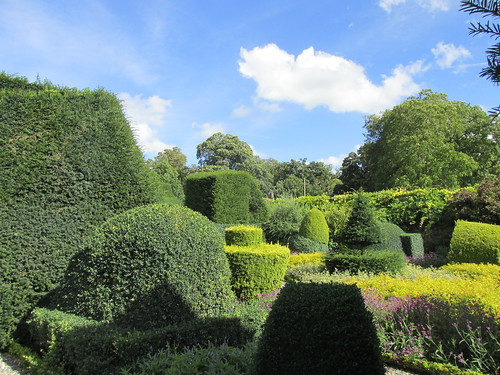 |
| Topiary at Levens Hall |
One of the most important topiary gardens in the UK is at Levens Hall in Cumbria. The garden was first laid out in the 1690s and has changed very little since. It is believed that some of the trees there are from the original planting. It was designed by Guillaume Beaumont, believed to have trained under Le Notre at Versailles, and one time gardener to James II.
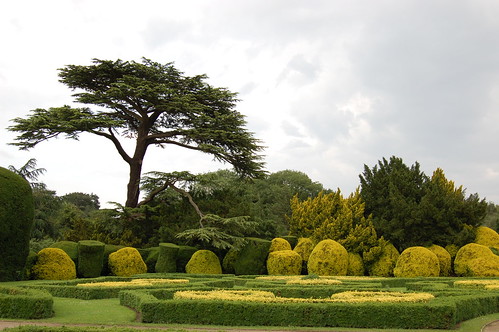 |
| Victorian taste at Elvaston Castle |
Today topiary is mainly restricted to a few extremely elaborate structures in smaller gardens, designed to create one showpiece, rather than a large display.
 |
| A modern example (Not my photo. Used with thanks.) |
Friday, 9 September 2016
Blackpool
Mr Anorak and I are on holiday. Guess where?
The Lion and Albert
by Marriott Edgar
There's a famous seaside place called Blackpool,
That's noted for fresh-air and fun,
And Mr and Mrs Ramsbottom
Went there with young Albert, their son.
A grand little lad was their Albert
All dressed in his best; quite a swell
'E'd a stick with an 'orse's 'ead 'andle
The finest that Woolworth's could sell.
They didn't think much to the ocean
The waves, they was fiddlin' and small
There was no wrecks... nobody drownded
'Fact, nothing to laugh at, at all.
So, seeking for further amusement
They paid and went into the zoo
Where they'd lions and tigers and cam-els
And old ale and sandwiches too.
There were one great big lion called Wallace
His nose were all covered with scars
He lay in a som-no-lent posture
With the side of his face to the bars.
Now Albert had heard about lions
How they were ferocious and wild
And to see Wallace lying so peaceful
Well... it didn't seem right to the child.
So straight 'way the brave little feller
Not showing a morsel of fear
Took 'is stick with the'orse's 'ead 'andle
And pushed it in Wallace's ear!
You could see that the lion didn't like it
For giving a kind of a roll
He pulled Albert inside the cage with 'im
And swallowed the little lad... whole!
Then Pa, who had seen the occurrence
And didn't know what to do next
Said, "Mother! Yon lions 'et Albert"
And Mother said "Eeh, I am vexed!"
So Mr and Mrs Ramsbottom
Quite rightly, when all's said and done
Complained to the Animal Keeper
That the lion had eaten their son.
The keeper was quite nice about it
He said, "What a nasty mishap
Are you sure that it's your lad he's eaten?"
Pa said, "Am I sure? There's his cap!"
So the manager had to be sent for
He came and he said, "What's to do?"
Pa said, "Yon lion's 'eaten our Albert
And 'im in his Sunday clothes, too."
Then Mother said, "Right's right, young feller
I think it's a shame and a sin
For a lion to go and eat Albert
And after we've paid to come in!"
The manager wanted no trouble
He took out his purse right away
And said, "How much to settle the matter?"
And Pa said "What do you usually pay?"
But Mother had turned a bit awkward
When she thought where her Albert had gone
She said, "No! someone's got to be summonsed"
So that were decided upon.
Round they went to the Police Station
In front of a Magistrate chap
They told 'im what happened to Albert
And proved it by showing his cap.
The Magistrate gave his o-pinion
That no-one was really to blame
He said that he hoped the Ramsbottoms
Would have further sons to their name.
At that Mother got proper blazing
"And thank you, sir, kindly," said she
"What! waste all our lives raising children
To feed ruddy lions? Not me!"
Written some time in the 1930s and made famous by Stanley Holloway. More about Blackpool to follow.
The Lion and Albert
by Marriott Edgar
There's a famous seaside place called Blackpool,
That's noted for fresh-air and fun,
And Mr and Mrs Ramsbottom
Went there with young Albert, their son.
A grand little lad was their Albert
All dressed in his best; quite a swell
'E'd a stick with an 'orse's 'ead 'andle
The finest that Woolworth's could sell.
They didn't think much to the ocean
The waves, they was fiddlin' and small
There was no wrecks... nobody drownded
'Fact, nothing to laugh at, at all.
So, seeking for further amusement
They paid and went into the zoo
Where they'd lions and tigers and cam-els
And old ale and sandwiches too.
There were one great big lion called Wallace
His nose were all covered with scars
He lay in a som-no-lent posture
With the side of his face to the bars.
Now Albert had heard about lions
How they were ferocious and wild
And to see Wallace lying so peaceful
Well... it didn't seem right to the child.
So straight 'way the brave little feller
Not showing a morsel of fear
Took 'is stick with the'orse's 'ead 'andle
And pushed it in Wallace's ear!
You could see that the lion didn't like it
For giving a kind of a roll
He pulled Albert inside the cage with 'im
And swallowed the little lad... whole!
Then Pa, who had seen the occurrence
And didn't know what to do next
Said, "Mother! Yon lions 'et Albert"
And Mother said "Eeh, I am vexed!"
So Mr and Mrs Ramsbottom
Quite rightly, when all's said and done
Complained to the Animal Keeper
That the lion had eaten their son.
The keeper was quite nice about it
He said, "What a nasty mishap
Are you sure that it's your lad he's eaten?"
Pa said, "Am I sure? There's his cap!"
So the manager had to be sent for
He came and he said, "What's to do?"
Pa said, "Yon lion's 'eaten our Albert
And 'im in his Sunday clothes, too."
Then Mother said, "Right's right, young feller
I think it's a shame and a sin
For a lion to go and eat Albert
And after we've paid to come in!"
The manager wanted no trouble
He took out his purse right away
And said, "How much to settle the matter?"
And Pa said "What do you usually pay?"
But Mother had turned a bit awkward
When she thought where her Albert had gone
She said, "No! someone's got to be summonsed"
So that were decided upon.
Round they went to the Police Station
In front of a Magistrate chap
They told 'im what happened to Albert
And proved it by showing his cap.
The Magistrate gave his o-pinion
That no-one was really to blame
He said that he hoped the Ramsbottoms
Would have further sons to their name.
At that Mother got proper blazing
"And thank you, sir, kindly," said she
"What! waste all our lives raising children
To feed ruddy lions? Not me!"
Written some time in the 1930s and made famous by Stanley Holloway. More about Blackpool to follow.
Subscribe to:
Comments (Atom)

